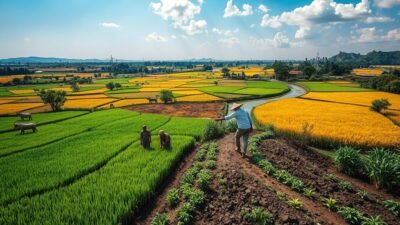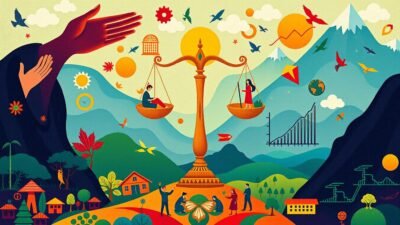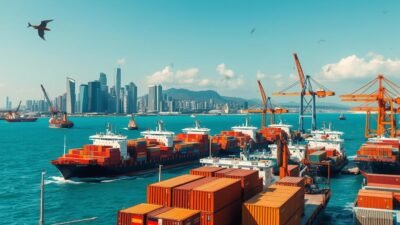Did you know the world’s population has grown from 1.6 billion in 1900 to 7.9 billion in 2022? This rapid growth affects our economic theories and plans for development. It’s important to understand how population changes impact our economy.
This article explores the changing world of population theories. We’ll see how these ideas have shaped our economic models and policies. From Thomas Malthus to today’s demographic transition theories, we’ll dive into the key debates in UGC NET Economics.
We’ll look at how these theories have influenced our economy over time. This includes how population affects economic growth, resource use, and society’s well-being. Whether you’re studying for the UGC NET Economics exam or just interested in the topic, this article will give you deep insights.
Key Takeaways
- The world’s population has quadrupled in the past century, with significant implications for economic theories and development strategies.
- Understanding the evolution of population theories is crucial for understanding economic models and development policies.
- Exploring the historical context and contemporary applications of population theories can provide valuable insights into the complex relationship between population dynamics and economic prosperity.
- This article aims to equip readers, including UGC NET Economics students and professionals, with a comprehensive understanding of the subject.
- The content focuses on informative, persuasive, and original analysis, avoiding generic placeholders and ensuring authenticity.
Understanding Population Dynamics in Economic Development
To grasp how population affects economic growth, we must look at key changes in population. The Demographic Transition Model helps us see how these changes impact economic growth.
Key Components of Population Change
Several factors influence how population changes affect economic growth. These include:
- Fertility rates
- Mortality rates
- Migration patterns
- Age structure of the population
Demographic Transition Model
The Demographic Transition Model explains how population growth changes with economic development. It shows four stages, each with its own effects on economic policiespolicies> and growth.
| Stage | Fertility Rate | Mortality Rate | Population Growth |
|---|---|---|---|
| Pre-Transition | High | High | Slow |
| Early Transition | High | Declining | Rapid |
| Late Transition | Declining | Low | Slow |
| Post-Transition | Low | Low | Stable |
Impact on Economic Growth Patterns
The Demographic Transition Model shows how population changes affect economic policies and growth. Knowing this helps policymakers and economists create better strategies for economic development.
“The interplay between population dynamics and economic development is a complex and multifaceted phenomenon, requiring a nuanced understanding of both microeconomic and macroeconomic factors.”
Historical Perspectives on Population Theories
The study of population dynamics has a rich history. It goes back to early economists and thinkers. These economic theory views have greatly shaped our understanding of population growth. They also show how it affects public finance and economic development.
Thomas Malthus, an 18th-century British economist, was a key figure. His work, “An Essay on the Principle of Population,” showed how population grows faster than food supply. He predicted that this would lead to poverty and famine.
David Ricardo built on Malthus’ ideas. He looked at how population growth, land scarcity, and agricultural production are connected. Ricardo’s work on rent and wealth distribution also influenced our understanding of population and economic development.
- Karl Marx and Friedrich Engels, the founders of Marxism, offered a contrasting view. They highlighted the impact of social and economic factors on population growth and distribution.
- In the 20th century, demographic transition theory provided a deeper understanding. It explained how birth and death rates change as a society develops economically.
These historical views have shaped modern economic theory and public finance on population dynamics. They help us understand the complex relationship between population and economic progress.
“The power of population is indefinitely greater than the power in the earth to produce subsistence for man.”
– Thomas Malthus, “An Essay on the Principle of Population”
| Economist | Key Contribution | Perspective on Population |
|---|---|---|
| Thomas Malthus | Introduced the concept of population growth outpacing food supply | Population growth will lead to widespread poverty and famine |
| David Ricardo | Explored the relationship between population growth, land scarcity, and diminishing returns in agricultural production | Population growth will lead to a decline in economic well-being |
| Karl Marx and Friedrich Engels | Emphasized the role of social and economic factors in population growth and distribution | Population dynamics are shaped by socioeconomic conditions |
| Demographic Transition Theory | Provided a more nuanced understanding of population change, explaining the shift from high birth and death rates to low birth and death rates as a society develops economically | Population dynamics are influenced by economic development |
Malthusian Theory and Modern Economic Reality
The Malthusian theory has long fascinated and sparked debate in microeconomics and environmental economics. Thomas Malthus proposed it, focusing on how population growth affects resource availability. Yet, today’s economy shows the Malthusian predictions were not entirely right. The reality is more complex than expected.
Critical Analysis of Malthusian Predictions
Malthus feared that population growth would outpace food production, causing famine and societal collapse. He suggested that without checks like war or disease, the population would grow too fast. But, the real growth of population and economy has not followed his dire forecast.
Contemporary Applications and Limitations
Today, technology and better farming have boosted productivity and resource use. This has slowed population growth in many places, challenging Malthus’s views. The demographic transition model also offers a deeper look into population changes.
Population Pressure on Resources
- Malthus’s worries about resource pressure are still valid but have changed over time.
- Climate change, environmental damage, and resource inequality are now major issues. They need a broader approach to tackle.
- Economists and policymakers must understand how population, economy, and resources interact. This is key to solving these complex problems.
The Malthusian theory is still thought-provoking but needs a deeper understanding. It helps us tackle the complex issues of population, resources, and economic growth.
| Metric | Malthusian Prediction | Modern Observation |
|---|---|---|
| Population Growth | Exponential and Unchecked | Slowing Growth Rates in Many Regions |
| Food Production | Lagging Behind Population Growth | Significant Advancements in Productivity |
| Resource Availability | Scarcity and Depletion | Sustainability Challenges and Unequal Distribution |
Understanding the Malthusian theory and its modern uses is crucial. It helps policymakers, economists, and researchers in microeconomics and environmental economics. They can develop better solutions for population-related challenges in today’s economy.
“The power of population is so superior to the power of the earth to produce subsistence for man, that premature death must in some shape or other visit the human race.”
– Thomas Malthus, “An Essay on the Principle of Population”
Population Growth and Economic Development Nexus
The link between macroeconomics and development economics is a topic of much study and debate. Population growth is key in shaping economic success. This part explores how population trends affect economic growth, showing different views on the topic.
Some believe that more people can help the economy grow. They say a bigger workforce can lead to more productivity and new ideas. They think investing in education and infrastructure can make a growing population a driving force for economic growth.
But others worry about the downsides of fast population growth. They say it can put a strain on resources and services, leading to more poverty and inequality. They also worry about running out of food and resources if the population grows too fast.
“The relationship between population growth and economic development is complex and often contentious. While some see population growth as an asset, others view it as a liability to sustainable progress.”
Studies show that how population growth affects the economy varies by country. Things like the stage of demographic transition, education levels, and resource availability matter a lot. These factors influence the connection between population and economic growth.
The discussion on population growth and economic development is ongoing. It’s a key area in macroeconomics and development economics. Policymakers and economists need to understand this complex relationship well. They must use detailed, evidence-based strategies to handle the challenges and chances brought by population changes.
UGC NET Economics: Population Dynamics and Growth Models
Aspiring economists need to grasp the link between population dynamics and economic growth. This part explores the theories, models, and policies that shape population economics.
Theoretical Frameworks and Applications
Population dynamics and economic growth are closely tied. Theories like Malthus and Solow help us understand this relationship. These ideas form the basis for studying how population affects economic development.
Mathematical Models in Population Economics
Econometrics uses math to study population’s effect on the economy. Models like regression and dynamic optimization help us see how population and economy interact. This knowledge guides policy decisions.
Policy Implications and Analysis
Research on population economics guides policy-making. It suggests ways to control population and invest in people. These strategies aim to use the demographic dividend for sustainable growth.
Understanding these concepts and tools is key for UGC NET Economics. It helps candidates see how population dynamics influence economic growth. This knowledge prepares them for the exam.
| Theoretical Framework | Key Insights | Policy Implications |
|---|---|---|
| Malthusian Theory | Population growth outpacing food supply leading to resource scarcity and economic stagnation | Population control measures, investment in agricultural productivity |
| Solow Growth Model | Demographic factors as determinants of economic growth, including population growth, labor force participation, and capital accumulation | Policies promoting human capital development, labor market participation, and capital investment |
| Demographic Transition Theory | Changing patterns of birth and death rates leading to population growth and demographic shifts | Policies addressing the challenges and opportunities of population aging, urbanization, and the demographic dividend |
Demographic Dividend: Opportunities and Challenges
When countries go through demographic changes, they often see a “demographic dividend.” This is when the number of working-age people grows faster than the number of dependents. This situation offers big economic policies chances, but it also brings unique international economics hurdles that need careful planning.
The demographic dividend can really boost economic growth. A bigger workforce means more productivity and savings. Countries like the East Asian tigers have seen huge economic gains by using this dividend well. But, to fully benefit from it, countries must invest in education, healthcare, and jobs to keep the workforce healthy, skilled, and employed.
| Opportunities | Challenges |
|---|---|
|
|
To make the most of the demographic dividend, countries need to adopt smart economic policies and international economics plans. They should invest in education, healthcare, and infrastructure. They also need to create jobs, make labor markets flexible, and have social safety nets. It’s important to plan and work together across different areas to turn the demographic dividend into lasting economic growth.
“The demographic dividend is a once-in-a-lifetime opportunity that must be seized with intentionality and strategic foresight.”
As countries face the challenges and chances of the demographic dividend, they must stay alert and flexible. Changes in demographics can greatly affect economic policies and international economics. Being able to predict and react to these changes will be key to a nation’s long-term economic success.
Population Aging and Economic Implications
As the world ages, the economic effects are huge. This change affects public finance and economic policies a lot.
Healthcare Systems Impact
More older people mean higher healthcare costs. They need more care. Governments must make healthcare systems work for the elderly. They need to keep care quality high and systems sustainable.
Labor Market Transformations
With fewer young workers, the labor market changes. This can cause shortages and skill gaps. New ways to manage the workforce, like promoting lifelong learning, are needed.
Pension Systems Sustainability
Pension systems face big challenges with an aging population. There are fewer workers to support retirees. Governments must reform pensions to keep them strong. This could mean raising retirement ages or finding new ways to fund them.
Dealing with population aging needs a big plan. It involves finance, labor, and social welfare changes. By tackling these issues, we can make sure aging populations are economically beneficial.
| Factors Affecting Population Aging | Potential Economic Implications |
|---|---|
|
|
“Addressing the economic implications of population aging requires a comprehensive and multifaceted approach, involving public finance strategies, labor market policies, and social welfare reforms.”
Policymakers and economists must find new ways to handle population aging. They need to ensure public finance and economic policies are sustainable for the future.
Urbanization Trends and Economic Growth
The link between urban growth and economic development is complex. Cities worldwide are expanding in population and economic power. It’s vital for experts and leaders to grasp this connection.
Cities are centers of innovation and economic chance. They have more resources, infrastructure, and people, leading to better efficiency and growth. Yet, the quick growth of cities also brings environmental and social challenges.
Urban growth affects development economics and environmental economics greatly. The smart use of resources, the pressure on public services, and the environmental impact of cities shape the economy.
The Benefits of Urban Concentration
- Increased productivity and innovation due to knowledge spillovers and agglomeration economies
- Greater access to diverse job opportunities and higher incomes
- Improved infrastructure and public services, such as healthcare and education
The Challenges of Urbanization
- Strain on urban infrastructure and public services
- Environmental degradation, including air and water pollution, waste management issues, and resource depletion
- Socioeconomic disparities and the rise of informal settlements and slums
| Indicator | Urban Areas | Rural Areas |
|---|---|---|
| GDP per capita | $45,000 | $22,000 |
| Poverty rate | 12% | 25% |
| Access to basic services | 90% | 70% |
Finding a balance between urban growth’s benefits and its challenges is key for sustainable development. Leaders must use strategies that support inclusive and green urban growth.
“The future of humanity is urban, and the more we can learn about the new reality of cities, the better equipped we will be to mitigate their challenges and harness their potential.”
Population Policies and Economic Planning
Population dynamics are key to economic growth. Effective population policies are vital for economic planning. Policymakers and economists face a complex challenge. They must balance population issues with economic goals.
Policy Implementation Strategies
Implementing population policies well needs a mix of strategies. Governments use economic policies like tax breaks and subsidies. They also run public awareness campaigns and educational programs to encourage family planning.
Economic Impact Assessment
It’s crucial to understand the economic effects of population policies. Economists use public finance models and cost-benefit analyses. These tools help predict how policies will affect GDP, jobs, and resource use.
Future Policy Directions
Policymakers must stay alert and flexible as population trends change. Future policies will focus on sustainable development. They aim to balance economic growth, environmental care, and social welfare. Integrating population into economic policies is key to managing the relationship between demography and economic progress.
| Policy Objective | Implementation Strategies | Expected Economic Impact |
|---|---|---|
| Stabilize population growth |
|
|
| Address population aging |
|
|
“Effective population policies are not just about numbers, but about empowering people and creating a sustainable future.”
Migration Patterns and Economic Development
The link between migration and economic growth is complex. Both international and internal migration affect labor markets and economic growth. People moving bring new skills and ideas that help economies grow.
In international economics, skilled workers and capital moving across borders can spark innovation. But, losing these workers can harm the countries they leave. Governments must balance the benefits and challenges of migration.
Looking at macroeconomic effects, when people move from rural to cities, it changes a lot. This can lead to more jobs and better productivity. Yet, it also puts a strain on cities’ resources. Planning and investing are key to managing this growth well.
FAQ
What is the importance of population dynamics in economic theory and development?
Population dynamics, like growth, aging, and migration, are key in economic theories and development. They greatly affect economic growth, resource use, labor markets, and prosperity.
How does the Demographic Transition Model explain population changes and their economic implications?
The Demographic Transition Model shows how population changes over time. It explains how lower birth and death rates can boost economic growth and development.
What are the key criticisms and limitations of Malthusian theory in modern economic contexts?
Thomas Malthus’ theory said population would grow faster than food, leading to famine. But, technology and economic changes have helped many countries avoid this problem.
How do population growth models and mathematical techniques contribute to our understanding of population economics?
Models and math help us study the link between population and economy. They give insights into how population changes affect economic growth.
What is the concept of demographic dividend, and how can countries leverage it for economic growth?
The demographic dividend is when a country has more working-age people than dependents. Countries can use this by investing in people, creating jobs, and making the most of their working-age population.
How does population aging impact economic systems, and what are the policy challenges associated with it?
Aging populations can strain healthcare and change labor markets. It also threatens pension systems. Policymakers must find ways to support aging populations, like improving healthcare and reforming pensions.
What are the economic implications of urbanization trends, and how can policymakers address the associated challenges?
Urbanization can boost growth by increasing productivity and innovation. But, it also raises challenges like infrastructure needs and environmental issues. Policymakers need to manage urban growth and ensure sustainable development.
How can population policies be designed and implemented to support economic planning and development?
Population policies, like family planning and migration, can support economic planning. Effective policies need careful planning, considering economic and social impacts, and adjusting to changes.
What are the economic implications of migration patterns, and how do they influence economic development?
Migration can change labor markets and skills, affecting growth. Policymakers must manage migration to benefit the economy, like integrating migrants and addressing skill gaps.





